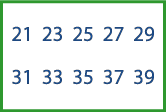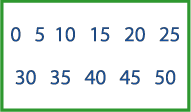Skip over navigation
Numbers can be sorted in many different ways. We are just going to be using the numbers from 0 to 50.
In this box there is a set of numbers:

In this box there is a different set of numbers:



Or search by topic
Number and algebra
Geometry and measure
Probability and statistics
Working mathematically
Advanced mathematics
For younger learners
Sorting Numbers
Age 5 to 7
Challenge Level 





Numbers can be sorted in many different ways. We are just going to be using the numbers from 0 to 50.
In this box there is a set of numbers:

They are the odd numbers between 20 and 40.
In this box there is a different set of numbers:

They are multiples of five.
Now you can make your own sets. Think of a good title for each of your sets.
You may also like
Biscuit Decorations
Andrew decorated 20 biscuits to take to a party. He lined them up and put icing on every second biscuit and different decorations on other biscuits. How many biscuits weren't decorated?
Constant Counting
You can make a calculator count for you by any number you choose. You can count by ones to reach 24. You can count by twos to reach 24. What else can you count by to reach 24?

